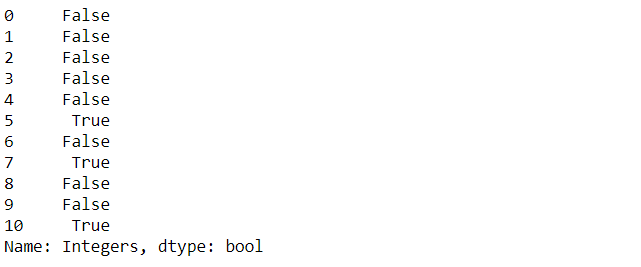检查 Pandas DataFrame 中的 NaN
NaN 代表 Not A Number,是表示数据中缺失值的常用方法之一。它是一个特殊的浮点值,不能转换为浮点以外的任何其他类型。 NaN 值是数据分析中的主要问题之一。为了得到想要的结果,处理 NaN 是非常必要的。

在 Pandas DataFrame 中检查 NaN 的方法如下:
- 检查单个 DataFrame 列下的 NaN:
- 计算单个 DataFrame 列下的 NaN:
- 检查整个 DataFrame 下的 NaN:
- 计算整个 DataFrame 下的 NaN:
方法一:使用 isnull().values.any() 方法
例子:
Python3
# importing libraries
import pandas as pd
import numpy as np
num = {'Integers': [10, 15, 30, 40, 55, np.nan,
75, np.nan, 90, 150, np.nan]}
# Create the dataframe
df = pd.DataFrame(num, columns=['Integers'])
# Applying the method
check_nan = df['Integers'].isnull().values.any()
# printing the result
print(check_nan)Python3
check_nan = df['Integers'].isnull()Python3
# importing libraries
import pandas as pd
import numpy as np
num = {'Integers': [10, 15, 30, 40, 55, np.nan,
75, np.nan, 90, 150, np.nan]}
# Create the dataframe
df = pd.DataFrame(num, columns=['Integers'])
# applying the method
count_nan = df['Integers'].isnull().sum()
# printing the number of values present
# in the column
print('Number of NaN values present: ' + str(count_nan))Python3
# importing libraries
import pandas as pd
import numpy as np
nums = {'Integers_1': [10, 15, 30, 40, 55, np.nan, 75,
np.nan, 90, 150, np.nan],
'Integers_2': [np.nan, 21, 22, 23, np.nan, 24, 25,
np.nan, 26, np.nan, np.nan]}
# Create the dataframe
df = pd.DataFrame(nums, columns=['Integers_1', 'Integers_2'])
# applying the method
nan_in_df = df.isnull().values.any()
# Print the dataframe
print(nan_in_df)Python3
# importing libraries
import pandas as pd
import numpy as np
nums = {'Integers_1': [10, 15, 30, 40, 55, np.nan, 75,
np.nan, 90, 150, np.nan],
'Integers_2': [np.nan, 21, 22, 23, np.nan, 24, 25,
np.nan, 26, np.nan, np.nan]}
# Create the dataframe
df = pd.DataFrame(nums, columns=['Integers_1', 'Integers_2'])
# applying the method
nan_in_df = df.isnull().sum().sum()
# printing the number of values present in
# the whole dataframe
print('Number of NaN values present: ' + str(nan_in_df))输出:

也可以获得存在 NaN 值的确切位置。我们可以通过从 isnull().values.any() 中删除 .values.any() 来做到这一点。
Python3
check_nan = df['Integers'].isnull()
输出:

方法二:使用 isnull().sum() 方法
例子:
Python3
# importing libraries
import pandas as pd
import numpy as np
num = {'Integers': [10, 15, 30, 40, 55, np.nan,
75, np.nan, 90, 150, np.nan]}
# Create the dataframe
df = pd.DataFrame(num, columns=['Integers'])
# applying the method
count_nan = df['Integers'].isnull().sum()
# printing the number of values present
# in the column
print('Number of NaN values present: ' + str(count_nan))
输出:

方法三:使用 isnull().values.any() 方法
例子:
Python3
# importing libraries
import pandas as pd
import numpy as np
nums = {'Integers_1': [10, 15, 30, 40, 55, np.nan, 75,
np.nan, 90, 150, np.nan],
'Integers_2': [np.nan, 21, 22, 23, np.nan, 24, 25,
np.nan, 26, np.nan, np.nan]}
# Create the dataframe
df = pd.DataFrame(nums, columns=['Integers_1', 'Integers_2'])
# applying the method
nan_in_df = df.isnull().values.any()
# Print the dataframe
print(nan_in_df)
输出:

要获得存在 NaN 值的确切位置,我们可以通过从 isnull().values.any() 中删除 .values.any() 来实现。
方法四:使用 isnull().sum().sum() 方法
例子:
Python3
# importing libraries
import pandas as pd
import numpy as np
nums = {'Integers_1': [10, 15, 30, 40, 55, np.nan, 75,
np.nan, 90, 150, np.nan],
'Integers_2': [np.nan, 21, 22, 23, np.nan, 24, 25,
np.nan, 26, np.nan, np.nan]}
# Create the dataframe
df = pd.DataFrame(nums, columns=['Integers_1', 'Integers_2'])
# applying the method
nan_in_df = df.isnull().sum().sum()
# printing the number of values present in
# the whole dataframe
print('Number of NaN values present: ' + str(nan_in_df))
输出:
